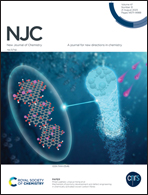Advancing an AIE dipyridyl derivative-based self-assembly system as a robust probe with enhanced fluorescence by metal ions for sensing multiple solvents†
Abstract
A series of AIE molecules (BPO, BPM, BPP) with small conjugation were successfully designed and synthesized using 6-(dodecylcarbamyl)picolinic acid. The AIE gels BPO, BPM, and BPP were obtained in different solvents, and the self-assembly process of BPM as a representative sample in 1,4-dioxane was characterized using different technologies. Interestingly, BPM exhibited a ‘turn-on’ fluorescence response towards Cd2+ with excellent selectivity and a low limit of detection (LOD) of 0.66 nM. The formation of complex BPM-Cd with the stoichiometry of 1 : 1 was confirmed through Job's plot. With the introduction of metal–ligand coordination bonds, complex BPM-Cd showed multiple stimuli responses to polar solvents, including H2O, DMF, DMSO, methanol, and ethanol, with LODs of 0.0039%, 0.0042%, 0.002%, 0.088%, and 0.12% (v/v), respectively. This study provides a new method for constructing AIE self-assembly systems and multifunctional organic probes with improved sensitivity and selectivity.



 Please wait while we load your content...
Please wait while we load your content...